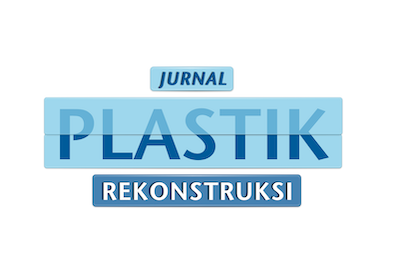Morphometric Variation of Maxilla in Mohammad Hoesin General Hospital
DOI:
https://doi.org/10.14228/pkk0gm94Keywords:
Morphometric variation, Maxilla Morphometric, ReconstructionAbstract
Background: Morphometry is a quantitative approach to finding information about variations in the shape of organisms. The maxilla has a central position and plays a vital role in supporting the viscerocranium. Morphometric variations are beneficial in reconstructive procedures and are an essential reference in plastic surgery. However, this study is currently limited. This study aims to determine variations in the maxillary morphometry of patients at Mohammad Hoesin General Hospital that may become a reference for maxillary reconstruction.
Method: This descriptive observational study with a cross-sectional approach aims to identify variations in maxillary morphometry in patients treated at RSUP Mohammad Hoesin Palembang. The study is directed at describing a community or society to create an objective picture or description of a condition. It continues by analyzing and comparing maxillary morphometry based on gender.
Results: In this study, the results were obtained from as many as 96 samples (male, n = 60, female, n = 36). Variable of male and female were assessed, namely intercanine width (3.58 ± 0.27cm; 3.44 ± 0.18cm), intermolar width (5.64 ± 0.43cm; 5.47 ± 0.27cm), arch length (3.31 ± 0.38cm; 3.32 ± 0.31cm, and palate height (2.46 ± 0.28cm; 2.35 ± 0.22cm) significant results were obtained that the dimensions of the male maxilla were more significant than those of females.
Conclusion: There are variations in maxillary morphometry based on gender. Males have larger inter canine width, intermolar width, and palate height morphometry than females.
References
1. Utkualp N, Ercan I. Anthropometric measurements usage in medical sciences. Biomed Res Int. 2015;2015.
2. Chrcanovic BR, Abreu MHNG, Custódio ALN. A morphometric analysis of supraorbital and infraorbital foramina relative to surgical landmarks. Surgical and Radiologic Anatomy. 2011;33(4):329–35.
3. Soriano RM, M Das J. Anatomy, Head and Neck, Maxilla [Internet]. PubMed. Treasure Island (FL): StatPearls Publishing; 2023 [cited 2023 Aug 3]. Available from: https://pubmed.ncbi.nlm.nih.gov/30860762/#:~:text=Excerpt
4. Soriano RM, Das JM. Anatomy, Head and Neck, Maxilla [Internet]. Nih.gov. StatPearls Publishing; 2019. Available from: https://www.ncbi.nlm.nih.gov/books/NBK538527/
5. Lubis H, Lubis M, Sutan C. The relationship of maxillary arch dimension with vertical facial morphology in proto-malay race. journal of orthodontic science. 2022;11(1):17.
6. Farooq A, Mahmood A, Jabbar A. Correlation of inter canine width with vertical facial morphology in patients seeking orthodontic treatment. Pakistan Oral Dent J 2015;35:213 15.
7. Saeed HK, Mageet AO. Dental arch dimensions and form in a Sudanese sample. J Contemp Dent Pract 2018;19:1235 41.
8. Peng X, Mao C, Yu G, Guo C, Huang M, Zhang Y. Maxillary Reconstruction with the Free Fibula Flap. Plastic and Reconstructive Surgery. 2005 May;115(6):1562–9.
9. Morotomi T, Iuchi T, Hirano N, Fujita M, Niwa K. Usefulness of customized titanium plates for midface contouring surgery. International Journal of Surgery Case Reports [Internet]. 2022 Jul 1 [cited 2023 Aug 6];96:107324. Available from: https://www.sciencedirect.com/science/article/pii/S2210261222005703
10. Yousof K, Darwich MA, Darwich K, Alassah G, Imran A, Nazha HM. A Case Report of Zygomatic Fracture Reconstruction: Evaluation with Orbital Measurements and Models Registration. Applied Sciences [Internet]. 2023 Jan 1 [cited 2023 Jul 22];13(10):6154. Available from: https://www.mdpi.com/2076-3417/13/10/6154
11. Lemeshow, S. & David W.H.Jr, 1997. Besar Sampel dalam Penelitian Kesehatan (terjemahan), Gadjahmada University Press, Yogyakarta
12. Rat Maxillary and Mandibular Growth within Three Generations — A Longitudinal CBCT Study. 2023;

Downloads
Published
Data Availability Statement
None
Issue
Section
License
Copyright (c) 2025 Mufida Muzakkie, Lawrencia Toline, Ratna Sari Devi, Ziske Maritska

This work is licensed under a Creative Commons Attribution-NonCommercial-NoDerivatives 4.0 International License.
Authors retain the copyright of the article and grant Jurnal Plastik Rekonstruksi the right of first publication with the work simultaneously licensed under a Creative Commons Attribution License. Articles opting for open access will be immediately available and permanently free for everyone to read, download and share from the time of publication. All open access articles are published under the terms of the Creative Commons Attribution-Non-commercial-NoDerivatives (CC BY-NC-ND) which allows readers to disseminate and reuse the article, as well as share and reuse of the scientific material. It does not permit commercial exploitation or the creation of derivative works without specific permission.













